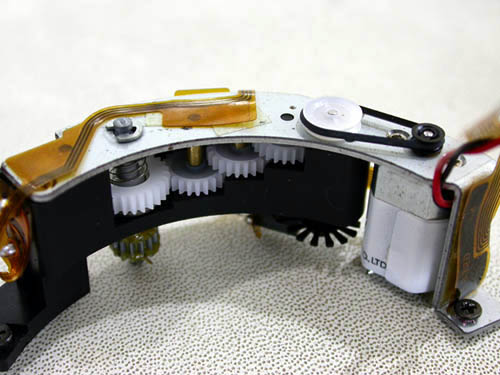Yes, both Nikon and Canon use two types of motors inside the SWM/USM lenses - ring type and the micro motor type.
But I don't think your list of which Nikon lenses uses which motor is accurate.
It is not difficult to tell which lens use the Ring-Type motor, just look at the contacts point at the end of the lens. Ten contacts points mean it is Ring-Type motor use. Eight contacts point mean it is mini DC motor use.
This is incorrect. Take a look inside your camera, just inside the mount at the top where the lens electrical contacts connect, you'll see that the pro Nikon bodies (F5, F100, D2series, D3series, D300 etc) have only 8 contacts (the lesser bodies like the D70, D40, F80 etc have only 7 contacts).
(found this image on the net to show the electrical contact points inside the camera)
AF lenses need 5 contacts (2 for power and ground for the lens; 3 for serial communication - communicating lens data back to camera, sending commands to lens like AF or turn VR on etc). AF-S or AF-I lenses need 8 contacts (1 extra high power contact for the lens motor and 1 ground for the lens motor, plus 1 extra read/write for the camera to track direction and speed of lens movement) - though some lesser AF-S lenses only have 7 contacts (eg. the 55-200mm), probably missing that extra read/write contact which the lesser bodies don't have as well since they only have 7 contacts too.
AF-I and AF-S lenses thus either have 10 or 8 (or even 7 for the lesser AF-S lenses) contacts.
So why do some AF-S lenses have 10 contacts - while even the pro bodies only have 8 contacts to match up to ?
Take a look at a Nikon AF-S teleconverter - it has 8 contacts on the camera side, but has 10 contacts on the lens side. The two extra contacts are for the teleconverter to tell the lens that it is connected to a teleconverter and which type (1.4x 1.7x or 2x) so that the lens reports back to the camera the proper aperture/focal length (thus a 70-200/2.8 when connected to a 1.4x teleconverter will report that it is a 98-280/4)
Even some AF-S lenses which weren't supposed to be used with the Nikon teleconverters had 10 contacts (eg. 17-35), but they'd work properly with Kenko teleconverters because of these contacts.
So Nikon made AF-S lenses with either 10 contacts or 7 contacts (for the lesser lenses). Even lenses which were not meant to be used with AF-S teleconverters had 10 contacts. Somewhere along the way among the newer AF-S lenses, Nikon must have decided to drop the 2 contacts for those lenses not meant to be used with the AF-S teleconverters, thus they only have 8 contacts (eg. 16-35, 24/1.4, 85/1.4 etc)



